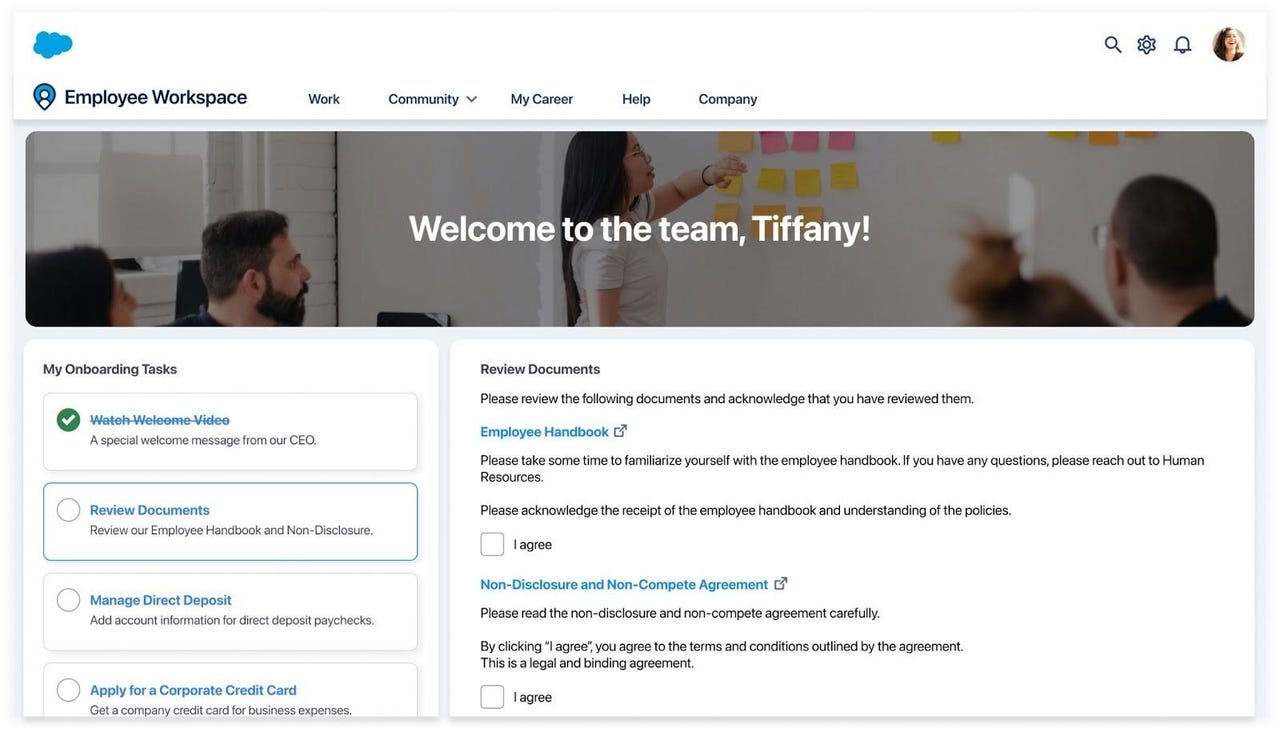Salesforce expands Work.com to move more formally into HR services


Employee onboarding with Work.com
More than a year after launching Work.com for post-pandemic planning, Salesforce is using the platform to formally move into the HR and "employee experience" market. The latest iteration of the platform puts Salesforce more directly in competition with other SaaS vendors with HCM products, like Workday and Oracle -- all cloud companies aiming to help organizations move to new models of hybrid work.
The new Work.com products focus on two areas -- employee growth and well-being, as well as employee service tools. The products were designed to meet the quickly changing needs of organizations adapting to the post-pandemic world, Jodi Innerfield, director of product marketing for Salesforce, told ZDNet.
Those needs, she said, "went from reopening the office to work from anywhere -- from work from home to this hybrid working world. And what we're hearing is that the technology that our customers used for employee experience, when everybody was in an office, just isn't cutting it anymore."
Work.com is introducing new Talent tools for both employees, as well as managers and HR teams. For employees, the Work.com Talent section offers a way to publish and track their skills, development goals and potential career paths. They can receive career guidance, such as learning recommendations and content from Trailhead, Salesforce's online learning platform. They can also use the Talent tools to find internal roles that align with their interests and career goals.
Meanwhile, managers and HR teams can use Work.com Talent to get insights into their workforce. For example, they can find people within the organization that have the skills needed to complete a new project or take on a new role.
The new HR tools were inspired by customers that have used Salesforce to build their own, customized talent solutions, Innerfield said. For instance, the professional services organization Jacobs has used Salesforce to build employee service tools for its global workforce of 55,000.
The new tools "definitely take us more formally into the category of tools that help support HR teams," Innerfield said, but "the real differentiator here is we're taking an employee-centric approach."
For instance, the new HR Service Center streamlines HR processes that are typically fragmented, like onboarding, into one integrated experience. Employees can also use the HR Service Center to search for answers about HR policies and benefits, or to complete HR tasks like updating a direct deposit. HR teams manage requests through a dedicated service console with AI-powered recommendations that automate case resolution.
The new Employee Service features also include a new Service Catalog, so employees can find products and services they can request, like a new laptop or a request to fix their mobile device. The Service Catalog lets organizations automate requests for common products and services.
There's also new Employee Concierge Bots to help employees answer questions.
To address employee well-being, Salesforce is introducing wellness checks into employee workflows. Based on how the employee responds to questions, it offers relevant content, such as tips on reducing stress or how to connect with a financial advisor.
The wellness checks are confidential, but leaders can get aggregated and anonymous insights into how their teams are doing. Innerfield said Salesforce is working with its Office of Ethical Use to ensure there are parameters on the tool to keep data confidential.
The employee-centric workflows and tools mirror the product developments that a number of other companies have introduced recently. Last year, for instance, Workday introduced new tools like Workday Journeys to guide employees through transitions such as a job change or maternity leave. Earlier this year, Oracle introduced its own "Journeys" platform to offer employees personalized HR guidance. Cisco, meanwhile, has added new digital wellness tools to Webex.